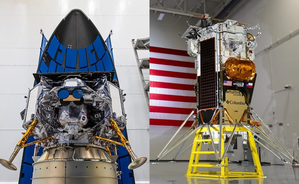Washington: Two US space companies, backed by NASA, are set to make a Moon landing in January and February.
The lunar missions come as the US has not attempted a moon landing since Apollo 17 in December 1972.
Pittsburgh-based Astrobotic Technology’s Peregrine lunar lander, which has successfully completed all integration milestones, aims to make the historic mission to the Moon on January 8. The lander will lift off aboard United Launch Alliance’s brand new rocket Vulcan.
After dwelling in a stable orbit and performing system checkouts, it aims to attempt the historic landing on February 23.
Peregrine is Astrobotic’s first lander mission, and the team plans to become the first commercial company to successfully land a spacecraft on the lunar surface.
The lander carries a total of 20 payloads, or cargo, including 5 from NASA’s Commercial Lunar Payload Services (CLPS) initiative.
The payload teams have missions that vary from seeking indications of water-ice near the lunar surface to demonstrating a rover swarm.
The lander also has several payloads representing humanity through artwork and historical artefacts.
“If you’ve been following the lunar industry, you understand that landing on the Moon’s surface is incredibly difficult. With that said, our team has continuously surpassed expectations and demonstrated incredible ingenuity during flight reviews, spacecraft testing, and major hardware integrations,” said John Thornton, Astrobotic CEO, in a statement. “We are ready for launch, and for landing,” he added.
Another is Houston-based Intuitive Machines, which aims to launch a lander in mid-February on SpaceX’s Falcon 9 rocket.
The IM-1 lunar lander was first expected to lift off on November 15 from Launch Complex 39A at the Kennedy Space Center.
However, in October, company officials warned of “pad congestion” which delayed the launch to January 12.
It was again delayed due to launch pad conflicts. Both Peregrine and IM-1 are carrying commercial payloads as well as those provided by NASA through its CLPS programme under awards made in 2019.
The CLPS initiative is a key part of NASA’s Artemis lunar exploration efforts. The science and technology payloads sent to the Moon’s surface as part of CLPS intend to lay the foundation for human missions and a sustainable human presence on the lunar surface.
Meanwhile, Japan Aerospace Exploration Agency’s (JAXA) moon lander is also planning to make the nation’s first-ever moon landing on January 20.
Its 2.7 metres Smart Lander for Investigating Moon (SLIM), which launched on September 6 along with XRISM, a powerful X-ray space telescope, successfully entered lunar orbit on Christmas day.
If successful in making a landing, Japan will become just the fifth country to successfully soft-land on the Moon, after Russia, US, China and India.
–IANS


Comments are closed.